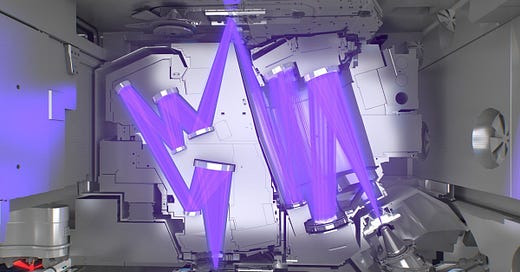World of Glass
What seems like the most basic of all materials turns out to be one of the most important and underrated. The wonders of glass.
The very first chapter of Material World was always going to be about glass, and in all honesty, before beginning work on it I was slightly dreading it. What, I figured, could one say of interest about something as simple and ubiquitous as glass?
Well, it turns out I was wrong - utterly wrong. What I presumed would be a shortish 3,000 word chapter very quickly ballooned into a mammoth novella-sized opus, because glass, it turns out, is massively, massively interesting.
It’s interesting because it’s arguably the world’s first advanced technology - whose origins go back millennia. That moment when humans first worked out how to melt sand and turn it into a valuable product (for most of human existence glass was a very expensive luxury) was one of those critical turning points in civilisation. Something was valuable not just because of what it was made from but because of the expertise and work that went into it.
But what’s even more interesting is that this isn’t just a history lesson. Even today much of what constitutes modern civilisation wouldn’t happen without the use of glass. Consider that most iconic of all modern technologies - the silicon chip. One of the main ways we etch transistors onto the silicon wafer is by using a technique known as photolithography.
The process of how this works these days is pretty mind-bending, and is covered in some depth in the third chapter of Material World but for our sakes the thing to note is that you need to bounce a laser beam off a number of reflectors and then onto the silicon wafer. And those reflectors are made of glass. An incredibly unusual, incredibly flat form of glass formed of layers of silicon and molybdenum… but glass all the same. Even today, glass is integral to the manufacture of the most advanced technology in the world.
But the importance of this material goes deeper still. One of the most intriguing things I encountered in my research was a book written a few years ago by Alan MacFarlane and Gerry Martin called The Glass Bathyscaphe. One of the claims they make in it is that without glass we’d never have had made most of the leaps we made in the enlightenment.
They run through the 20 most important scientific experiments in history and find that all but four of them relied in one way or another on glass. Everything from Robert Boyle and Robert Hooke’s creation of a vacuum chamber to Isaac Newton’s theory of light to Michael Faraday’s investigations into electricity - all of these experiments used glass vessels and prisms and lenses. Glass, it turns out, is perhaps the world’s most underrated general purpose technology, since it has enabled us to do so much more. It’s the foundation of modern science.
You could go further. You could make the argument that the very reason the scientific and cultural enlightenment happened where it did - in certain parts of Europe like Italy, France and the UK - was because those were also the dominant centres of glass production. There’s a risk of confusing causation with correlation, but it’s an intoxicating theory nonetheless.
As is another one which has been made most famously by David Hockney: that we owe the very Renaissance to glass lenses and mirrors. The reason artists began to be able to produce more life-like paintings, deploying realistic perspective and perfect lighting effects, he says, was thanks to lenses and mirrors. It’s a contested theory - but, I think, a compelling one. You see: everything comes back to glass.
And once you get a little bit obsessed with glass (which I guarantee you will be having read Material World) you suddenly find it hard to escape. In the run-up to publication I finally got around to reading Richard Rhodes’ The Making of the Atomic Bomb. And glass just kept cropping up.
It’s there in the labs in Cambridge where Ernest Rutherford is trying to split the atom, using special glass vessels throughout. It’s there in the post-Rutherford era when, it turns out, scientists like Otto Frisch were stymied in their attempts to make further breakthroughs by the availability of glass: “the laboratory glassblower’s first priority was Oliphant’s secret war work [the cavity magnetron, a precursor to the radar].”
Glassblowers are rarely mentioned in accounts of the development of nuclear physics and atomic weapons but it turns out they played a critical role in facilitating the experiments: the right kind of glass in the right shape.
All of which is to say: glass is amazing! Even more amazing are some of the stories about the lengths we’ve gone to throughout our history to get hold of this stuff. The story of glass is a story of tech transfer, of industrial strategy and of subterfuge. There are twists and turns in there that will take your breath away.
The good news is I managed to trim down the chapter from its novella length original draft but it’s still chock-full of unexpected nuggets and I think you’ll enjoy it. So… plug time. Buy the book! It’s out now, available from all good bookstores in the UK. Out in the US in November.






Loved the chapter Ed, a real page-turner. One fascinating fact about glass that is even less known is that water can also form a glass. In fact most of the water in the universe is thought to exist as glass.
Ed, thanks for getting your book out. I have a copy and am very much enjoying it. Glad you chose to emphasise sand. Thanks for the acknowledgement. Andrew Rabeneck